|
|
|
|
|
Where we are...
|
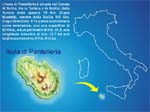
|
|
|
How to arrive
|
You can arrive to
Pantelleria from Milan
and Rome by charter
flights...
From Milan, Rome and
Trapani by Airone
flights...
From Palermo by
Meridiana flights...
From Trapani by
Siremar ship...
From Mazara by
Tirrenia ship...
From Trapani by Ustica
Lines speedboat...
[details]
|
|
|
|
|
|
|
|
|
|
|
Dammuso
The typical construction of Pantelleria
The island of Pantelleria has been inhabited since
pre-historic times. Ruins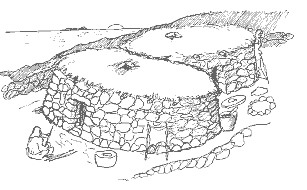 show that the first inhabitants possessed architectonic and
constructive methods very diverse from other peoples' of the ancient world. It is
precisely the unique nature and position of the island that has influenced the inhabitants
for generations. The remaining traces of these ancient peoples are exceptional; above all,
a pre-historic fortified village, located at Mursia, constructed on the edge of the sea
and encircled by a grandiose wall. A work which shows exceptional building skills, that
these peoples have passed down, together with the building of huts, whose remains have
been visible since the extensive archeological digs conducted by Professor Tozzi of the
University of Pisa and the Archeoclub of Pantelleria in the 60's and 70's. It is worth
visiting the island just to admire this unique patrimony. One has to remember that these pre-historic buildings
evolved at the time of the first Punic and Roman colonizations, which characterize the
island's two different construction methods, one by using the local volcanic stone, the
second by building a characteristic vaulted roof. In this way a very solid living space is
built, making it durable, fire resistant and well adapted to the island's
climate. show that the first inhabitants possessed architectonic and
constructive methods very diverse from other peoples' of the ancient world. It is
precisely the unique nature and position of the island that has influenced the inhabitants
for generations. The remaining traces of these ancient peoples are exceptional; above all,
a pre-historic fortified village, located at Mursia, constructed on the edge of the sea
and encircled by a grandiose wall. A work which shows exceptional building skills, that
these peoples have passed down, together with the building of huts, whose remains have
been visible since the extensive archeological digs conducted by Professor Tozzi of the
University of Pisa and the Archeoclub of Pantelleria in the 60's and 70's. It is worth
visiting the island just to admire this unique patrimony. One has to remember that these pre-historic buildings
evolved at the time of the first Punic and Roman colonizations, which characterize the
island's two different construction methods, one by using the local volcanic stone, the
second by building a characteristic vaulted roof. In this way a very solid living space is
built, making it durable, fire resistant and well adapted to the island's
climate.
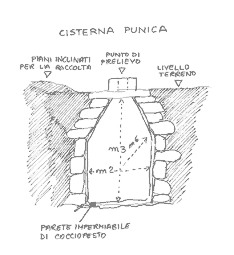 The environment was greatly revolutionized by the building
of cisterns during the Punic-Roman period. Many farms were built and in a greater part of
Pantelleria an agricultural development arose. It must be stressed that apart from
periodic cleaning there has been no other intervention needed, and these cisterns are
perfectly functional today after 2500 years of constant use. At this point, a question
arises: what kind of modern building material will last for centuries to come?
Notwithstanding the different peoples who inhabited the island, these methods of
construction have been so functional that they have been used for many centuries The environment was greatly revolutionized by the building
of cisterns during the Punic-Roman period. Many farms were built and in a greater part of
Pantelleria an agricultural development arose. It must be stressed that apart from
periodic cleaning there has been no other intervention needed, and these cisterns are
perfectly functional today after 2500 years of constant use. At this point, a question
arises: what kind of modern building material will last for centuries to come?
Notwithstanding the different peoples who inhabited the island, these methods of
construction have been so functional that they have been used for many centuries
THE DAMMUSO
The dammuso, the architectural symbol of Pantelleria was created in the 10th century A.D.
and it evolved and developed up until the 17th century. Because of the strategic position
of the island (in the Mediterranean) there were constant invasions by pirates and other
marauding peoples. When these incursions ceased, the people who had originally lived
together (in the area of the castle today), felt safe
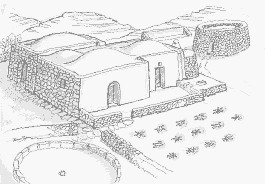 enough to move out and build homes
on other areas of the island. So new villages were built in the most fertile areas thus
increasing the number of dammusi. By looking at the construction of the dammusi today, one can think they were designed by
engineers, architects and ecologists. enough to move out and build homes
on other areas of the island. So new villages were built in the most fertile areas thus
increasing the number of dammusi. By looking at the construction of the dammusi today, one can think they were designed by
engineers, architects and ecologists.
The exceptionally wide walls are necessary to support the
domes which are finished with a mixture of red tufo and plaster which is treated by
beating these two components together for many days, thus forming a hard and waterproof
surface. The particular shape of the rounded roofs has been conceived above all for the
collection and canalization of rain water into the cisterns which are situated in close
proximity to the dammuso. The thick walls of these houses isolate them, keeping the rooms
cool in the summer and warm in the winter. As the dammusi are built out of the natural
stone found on the island, they blend in very well in the surrounding landscape. The
elements which complete the basic unit of the dammuso are: 'il forno' - a wood burning
oven - , the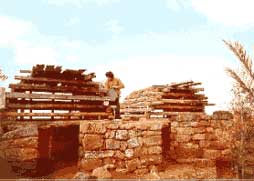 stable, the courtyard, the 'stenditoio', the 'passiaturi' and the garden. The
interior of the dammuso is made up of 3 spaces. The main room, a small bedroom and an
alcove (which is commonly used as the main bedroom). The alcove adjoins the main room via
a big arch, usually closed by an embroidered or lace curtain, clearly of middle-eastern
influence. The oven is located in a space adjacent to the dammuso, which includes a series
of stoves for cooking with wood. Each dammuso has a few stone-built stables , of different
sizes depending on the number of animals to be kept in them, such as mules, donkeys,
goats, cows and pigs. The courtyard, called aira in the local dialect, is round and has a
diameter of about 5 meters, and was used to thresh the grain, oats and barley. It was
built so that the blindfolded donkey or mule could walk in a circle and trash grain. The
stenditoio, called stennituri in the local dialect, is used to dry grapes, figs and
tomatoes. It is slightly sloped and is built on the south face of the dammuso thus
exposing it to the most sunlight. U Jardino is a stone garden built like a temple,
designed for citrus plants, such as lemons, limes, mandarins and oranges. It has high
walls to protect the trees from the strong winds and to keep the temperature warm in the
winter. stable, the courtyard, the 'stenditoio', the 'passiaturi' and the garden. The
interior of the dammuso is made up of 3 spaces. The main room, a small bedroom and an
alcove (which is commonly used as the main bedroom). The alcove adjoins the main room via
a big arch, usually closed by an embroidered or lace curtain, clearly of middle-eastern
influence. The oven is located in a space adjacent to the dammuso, which includes a series
of stoves for cooking with wood. Each dammuso has a few stone-built stables , of different
sizes depending on the number of animals to be kept in them, such as mules, donkeys,
goats, cows and pigs. The courtyard, called aira in the local dialect, is round and has a
diameter of about 5 meters, and was used to thresh the grain, oats and barley. It was
built so that the blindfolded donkey or mule could walk in a circle and trash grain. The
stenditoio, called stennituri in the local dialect, is used to dry grapes, figs and
tomatoes. It is slightly sloped and is built on the south face of the dammuso thus
exposing it to the most sunlight. U Jardino is a stone garden built like a temple,
designed for citrus plants, such as lemons, limes, mandarins and oranges. It has high
walls to protect the trees from the strong winds and to keep the temperature warm in the
winter.
|
|
|
